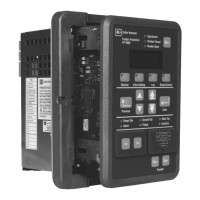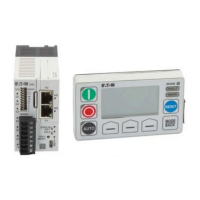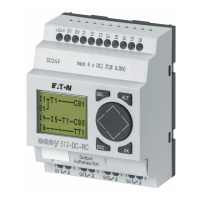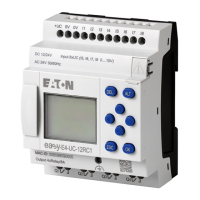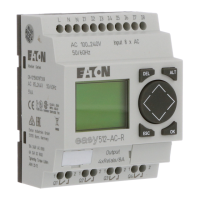Page 92 I.L. 17562
PR 0.3 Effective 8/99
Note that, for now, we assume that the three phase currents are balanced and have proper 120
degree phase relationship (i.e., only positive sequence current). If negative sequence current
reflecting unbalance is present, the MP-3000 gives much heavier weighting to the heating effect
of these currents, and tripping will occur sooner than expected from balanced-current curves.
9.1.3.1 Instantaneous Overcurrent Function — This function is intended mainly to trip for
high-current faults. The example instantaneous overcurrent setpoint used in Figure 9.2 is
12 times (1200 percent) of FLA. In general, the instantaneous overcurrent setpoint (IOC, P3L4)
should be at least 1.5 times LRC - well above the locked-rotor current normally seen at the
moment of a start.
CAUTION
Most contactors are not rated to interrupt high-current faults. Frequently, the motor control
center also contains fuses, which can interrupt these fault currents.
The MP-3000 trip command is intended to open all three phases via the contactor and block
further starting, but the fuses must interrupt the large current in faulted phase(s). If the contactor
interrupting rating is exceeded when the MP-3000 trips without this fuse backup, the contactor or
motor control center could be destroyed in a hazardous or explosive cascading fault situation.
Another acceptable application is to connect the MP-3000 to directly trip a circuit breaker which
has an interrupting rating exceeding the highest available bolted-fault current.
IOC should trip fast; no run or pickup delay is provided. A start delay (IOCSD, P3L5) is set at a
minimum of two cycles, or more if needed to block IOC tripping on magnetizing inrush when the
motor is first energized. Note that the entered IOCSD value is the total IOC trip time, including
pickup time of the basic IOC measurement algorithm, and cannot be set below two cycles.
9.1.3.2 Locked-Rotor Function — The family of curves shown in Figure 9.2 is based upon a
locked-rotor current setpoint (LRC, P1L2) of 6.1 times (610 percent) of FLA (P1L1) and a family
of locked-rotor or stall time setpoints (LRT, P1L3).
All curves shown in Figure 9.2 are based on a maximum allowable stall time from a cold start.
The nameplate LRT used for setting is normally a cold-start value. Since the thermal algorithm
actually retains recent operating history as reflected in the thermal bucket level, it is not
necessary to program the MP-3000 for hot starts – hot start protection is automatic. Note that
the effective limit curve for a hot start is actually more restrictive, i.e. more limiting in time and
current, than the cold-start curve of Figure 9.2.
The Emergency Overrride function, if invoked, lowers the thermal bucket to cold level regardless
of recent history and restores the cold-start curve. Use this only for a real process emergency –
it defeats the thermal-modeling protection, and the motor is at risk.
9.1.3.3 Ultimate Trip — The setpoint for the ultimate trip function is the value of current above
which the motor can be damaged over time. Figure 9.2 shows a setting of 100 percent,
reflecting a nameplate service factor of 1.0 and an ambient temperature that doesn’t rise above
40 degrees C. If the motor has a service factor different from 1.0, the ultimate trip current level
is adjusted accordingly. Other common service factors are 0.85 (UTC=85%) and 1.15
(UTC=115%).
As explained above and in Section 5, UTC sets the upper continuous limit if stator RTD
temperature measurements are not available. The time to trip after the UTC threshold is
crossed depends on recent operating history, and on the thermal-bucket size defined by
setpoints. With stator RTDs reporting acceptable temperature, the algorithm can allow sustained
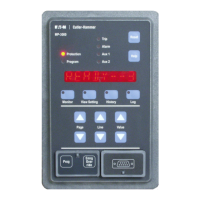
